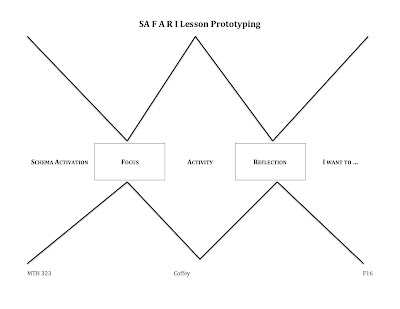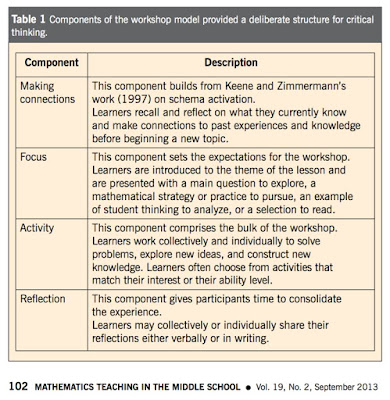One of the projects the pre-service elementary teachers (math majors) that I teach worked on this semester was designing a 4th-grade statistics lesson to address 4.MD.B.4.
The teachers went through a design cycle to make the lesson. They ...
- Built empathy by observing two fourth-grade classes;
- Defined the problem by developing a User/Needs/Insight statement;
- Brainstormed a variety of possible activities;
- Developed a prototype SAFARI Lesson;
- Tested the lesson by sharing it with the classroom teacher; and
- Revised it based on her feedback.
Three teachers co-taught the lesson in two different fourth-grade STEM classes. They made adjustment between the lessons based on what worked and what didn't. Afterwards, they reflected on the experience and shared the lesson with me. The lesson was so cool, I decided to make a few adjustments and use it in another class for pre-service elementary teachers (mostly non-math majors) that I teach. Here is the SAFARI Lesson that I taught.
Schema Activation - Prediction
Directions: "You have two sticky notes. On the green sticky, I want you to predict the number of seconds you think it would take you to write the alphabet from A to Z. On the purple sticky, I want you to predict how long it would take you to write the alphabet in reverse order from Z to A. You have a quarter of a minute. Go!"
Focus - 5.MD.B.2
Share lesson target: "We are going to make line plots to display data sets of measurements in fractions of a unit."
[Anticipated learner responses are in brackets.]
"Who thinks they can write the alphabet forward the fastest? [13 seconds or 2 letters per second] Who thinks they will take the most time to write the alphabet forward? [52 seconds or 1 letter every 2 seconds] Alright, let's get up and stand in order from fastest predicted time to slowest predicted time."
Learners order themselves
"As I listened in, it became apparent that several of you made similar predictions. It would be interesting to see how the predictions cluster. But we could potentially have a lot of unique guesses. In order to gather those guesses, let's round our predictions to the nearest quarter-of-a-minute. For example, Sam guessed 20 seconds forward and 55 seconds backwards. He would round to 1/4 of a minute for forward and one minute, four-fourths, backwards. Work with your neighbors to round your predictions to the nearest quarter-of-a-minute and then post them on the board - forward at the front and backwards at the back."
Learners post rounded predictions
"What do you notice about the data sets?" [The writing in reverse predictions are "higher" and more spread out than the forward predictions.]
"Why?" [We are familiar with writing the alphabet forwards so we think we can do it faster and know more what to expect.]
Activity - Writing the Alphabet in Reverse Order
Directions: "I am going to give you three pieces of paper."
At this point in my lesson, one of the pre-service teachers asked, "We're really going to get to do it, aren't we? We're really going to find out how long it takes us to write the alphabet from Z to A? Is it weird that I am so excited about this?" I reassured her that it wasn't weird - that my other pre-service teachers had designed a pretty cool lesson.
 Directions continued: "You have a choice. On the yellow paper, you may write the alphabet forward on one side and use it to help you to write it from Z to A on the other side. You'll see the second sheet has the alphabet already on the back in the form of classic blocks, like the ones my grandson plays with. If you choose that one, you will incur a 1/2 minute penalty, which means you will add 30 seconds to your time. The last piece is simply scrap paper; use it if you want to try to write the alphabet from Z to A without any other support.
Directions continued: "You have a choice. On the yellow paper, you may write the alphabet forward on one side and use it to help you to write it from Z to A on the other side. You'll see the second sheet has the alphabet already on the back in the form of classic blocks, like the ones my grandson plays with. If you choose that one, you will incur a 1/2 minute penalty, which means you will add 30 seconds to your time. The last piece is simply scrap paper; use it if you want to try to write the alphabet from Z to A without any other support."A few more things:
- You must start at Z and write the letters in reverse order to A. You can't cheat and start at A on the right-side of your paper.
- The letters must be legible. Your table-mates will decide if they can read your letters, and you will earn a 5 second penalty for each letter they can't read.
- When you finish, check the timer on the front board, record your time, and round it to the nearest quarter-of-a-minute.
At this point, a student rose his hand to ask a question. The girl who was so excited blurted out, "I just want to get started!" The other student asked if the letters had to be upper or lower case. I said it didn't matter to me.
Set the online stopwatch and say, "Go!"
When everyone is finish, have learners trade papers check letters for legibility.
Reflection - Noticing and Naming
Directions: "If you used the yellow paper (wrote A to Z on the back), write your result, to the nearest quarter-of-a-minute, on the yellow sticky note. If you used the blocks, and added 30 seconds to your time, write your rounded result on the blue sticky note. If you did it without any support, write your rounded result on the pink sticky note. Your rounded results go on the line plot on the back board underneath your predictions."
"What do you notice?" [Look for opportunities to introduce terminology related to measures of center and spread, like median, mode, and range]
I want to ... - Choice
Directions: "What do you want to do now? Here are some ideas:
- Try it again using a different level of support and add it to the line plot;
- See if there is a difference between writing in upper and lower case;
- Try it forward and compare it with your prediction;
- Gather more data from your friends and family over Thanksgiving;
- Consider other activities that ask people to do familiar things in unfamiliar ways and what the data might show; or
- Come up with your own idea to extend your learning."
















